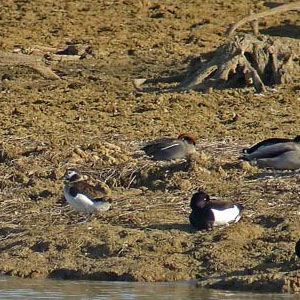Magazine | Analyses
Importante arrivée d’Hareldes boréales en France au cours de l’hiver 2007-2008

Harelde boréale (Clangula hyemalis) sur le lac de la Forêt d’Orient (Aube) en février 2008.
Photographie : Fabrice Croset
Introduction
La Harelde boréale (Clangula hyemalis) est un petit canard plongeur marin nichant dans la toundra hivernant principalement (pour les populations scandinave et sibérienne) en Mer Baltique, où elle se nourrit de mollusques, de crustacés et de petits poissons.
En France, l’espèce est une hivernante rare (moins de 100 oiseaux chaque hiver, souvent quelques dizaines seulement), et la mer d’Iroise (Finistère) constitue le principal secteur d’hivernage.
Alors que les hivers 2004-2005 et 2005-2006 semblent avoir été plutôt mauvais ou moyens, celui de 2007-2008 apparaît nettement meilleur.
Dans cet article, nous vous proposons une présentation de cette espèce souvent méconnue des observateurs car discrète (souvent en plongée) et rare, et nous vous apportons des éléments de réflexion sur l’hivernage de l’espèce en France et sur les raisons possibles de l’existence d’hivers plus favorables à l’observation de ce petit canard dans l’hexagone.
Abstract
The long-tailed duck (Clangula hyemalis) is a small, neat sea duck. Long-tailed Ducks show a bewildering variety of patterns depending on their age, their sex and the time of year but they are invariably a mixture of black, white and brown, usually white on the flanks and face.
The male is mainly white with some brownish-black markings. Females are browner. In flights, they show all dark wings and white bellies.
They characteristically land at sea with an unceremonious belly-flop.
This duck has a wide distribution at high latitudes in Eurasia and North America. Most of the birds inhabiting northern Europe are wintering in the Baltic Sea. This population is estimated at 4.5 millions of individuals, but only a few thousand reach the Wadden Sea and the Eastern British coasts.
A few birds (less than 100) can be watched in Winter in France, mainly on the coast, the Douarnenez Bay (Brittany) being probably the best one even if there’s no real pattern of data.
The 2005-2006 and 2006-2007 were not very good, but this 2007-2008 Winter seems to be better. In this article, we propose you a presentation of this little duck and some elements to understand why some Winters are better than others to discover it in France.
Poursuivez la lecture de cet article, en vous abonnant dès maintenant !
Découvrez les Archives d’Ornithomedia.com
Pour seulement 10,00 €TTC/an (ou 6,00 € les 6 mois)
Profitez de plusieurs centaines d’articles en accès illimité et sans aucun engagement.
Compléments
À lire aussi sur Ornithomedia.com
Observer les oiseaux en hiver dans la partie ouest du Lac Léman
À lire sur le web
- Le site d’Olivier Laporte : http://digiscopies.free.fr/
- Le site de Jopel Bruezière : www.eyesonsky.com
- Le site web www.ornitho.ch
- La liste de diffusion Coches-fr : groups.yahoo.com/group/coches-fr/
Ouvrage recommandé
Le guide Ornitho de L. Svensson et al
Sources
- Mullarney et al., Le guide ornitho : Les 848 espèces d’Europe en 4000 dessins (Grant)
- VASIL ANANIAN AND PETER DE ROUW , The first Long-tailed Duck Clangula hyemalis in Armenia, OSME
- Meèislovas ÞALAKEVIÈIUS, Saulius ÐVAÞAS, Global climate change and its impact on wetlands and waterbird populations, Acta Zoologica Lituanica, 2005, Volumen 15, Numerus 3




Aucun commentaire sur ce sujet
Participer à la discussion !